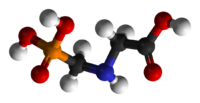
Photo from wikipedia
Cadmium (Cd) pollution has led to a serious deterioration in soil quality, plant growth, and human health. Therefore, restoration of soil quality is imperative. Phytoremediation is inexpensive and yields acceptable… Click to show full abstract
Cadmium (Cd) pollution has led to a serious deterioration in soil quality, plant growth, and human health. Therefore, restoration of soil quality is imperative. Phytoremediation is inexpensive and yields acceptable outcomes. Phytoremediation involves interaction between plant physiology and microbial activity and has been widely used in the remediation of Cd-contaminated soil. In the present study, Lolium perenne L. (perennial ryegrass) was planted in Cd-spiked soil and indole-3-acetic acid (IAA) was used to explore the physiological and biochemical characteristics of ryegrass as well as soil enzyme activity to remove Cd. The present study provides a theoretical basis for the phytoremediation of Cd-contaminated soil. The study investigated the effect of 30-mg/kg Cd-spiked soil on ryegrass (C) and 30-mg/kg Cd-spiked soil on ryegrass treated with 10-mg/kg IAA (CI) compared with uncontaminated soil and ryegrass as the control. At the end of the experiment, the ryegrass biomass, total chlorophyll, superoxide dismutase (SOD) activity, and soil invertase activity in C group were decreased by 33.7%, 23.0%, 29.7%, and 18.3%, respectively, whereas the peroxidase (POD) activity and soil basal respiration increased by 17.1% and 87.9%, respectively, compared with the control. In the CI group, the biomass of ryegrass, chlorophyll content, SOD activity, sucrase activity, fluorescein diacetate (FDA) hydrolase activity, and Cd removal rates increased by 14.5%, 19.9%, 24.3%, 12.1%, 20.4%, and 15.1%, respectively, whereas the POD activity, soil basal respiration, and Cd residues in the soil declined by 8.0%, 15.0%, and 17.0%, respectively, compared with the C group. Therefore, exposure to exogenous IAA alleviated the Cd stress on ryegrass and soil microorganisms and improved Cd absorption by ryegrass from the contaminated soil.
Journal Title: Environmental Science and Pollution Research
Year Published: 2022
Link to full text (if available)
Share on Social Media: Sign Up to like & get
recommendations!